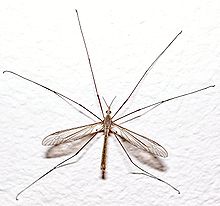Hold

As Halteren to be so-called halteres reduced wing , respectively. The insects use them to determine their orientation in space. The term is derived from historical one-handed dumbbells .
One finds holders in two insect orders :
- Fan-winged (Strepsiptera): the front wings are converted to swinging bulbs
- Two-winged (Diptera): the hind wings are converted to swinging arches.
These wing stubs consist of a stem and a thickening at the end and are similar in shape to drumsticks. Especially at the base, they are occupied with numerous sensory organs in the form of dome-shaped sensory organs (campaniform sensillae) that perceive curvatures of the cuticle . The brackets are raised and lowered in an anti-parallel manner to the flapping of the wing at a high frequency and measure the speed and acceleration of the rotation according to the principle of a vibration gyro .
The holders beat up and down at the frequency of the wing beat. They perform a pendulum movement, which geometrically has the same properties as a circular movement. Similar to a top, a pendulum has the tendency to withstand forces that try to tilt its plane of oscillation. If the direction of flight of the insect changes, the plane of oscillation of the holder heads persists and the base of the holder stems bends. Due to the insect's sensory equipment, the direction and strength of the deflection of the holder base can be measured and corresponding correction movements can be controlled.
The oscillation planes of the holders are approximately perpendicular to each other and each approximately at an angle of 45 ° to the longitudinal axis of the insect.
In the blowflies (Calliphoridae), the swing radius of the holders is covered by a hairy chitin crescent, which presumably has the task of protecting the holders from the influence of gusts of wind.
With the blow fly Calliphora erythrocephala one can observe that the holder vibrations are not only associated with wing movements, but also always take place during running movements. This sensory organ may be sensitive enough to generally measure changes in the direction of movement.
Individual evidence
- ^ Pringle, John William Sutton: The gyroscopic mechanism of the halteres of Diptera. Philosophical Transactions of the Royal Society of London. Series B, Biological Sciences (1948): 347-384.
- ^ Hengstenberg, Roland: Biological sensors: Controlling the fly's gyroscopes. Nature, Vol. 392, No. 6678, 1998, pp. 757-758.
